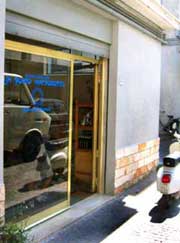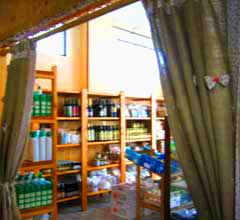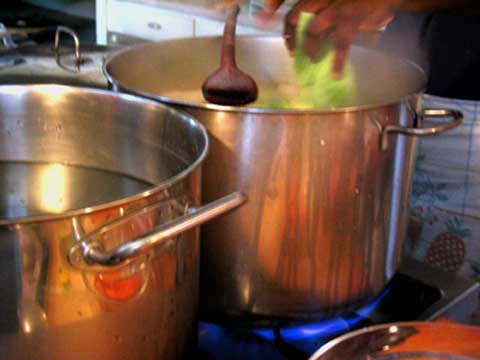


The entrance to the UPM restaurant
In a world full of meat-eaters, I often feel like the minority, choosing to leave the animals off my plate. My diet seems to throw restaurants for a loop when I constantly order sandwiches "minus the meat" or pizza "hold the cheese." To most, the meat and the dairy are the meal. But I, being a pure vegetarian, prefer not to eat those items. So, when I heard about a macrobiotic restaurant in Cagli ("that means you can eat there," I was told) I was excited. I had never heard of macrobiotics. I have so much to learn.
A few Loyola students and I decided to try it for dinner one night, and we were met with an unusual experience. We wandered a few blocks from school to find the glass-front we were looking for: UN PUNTO MACROBIOTICO in royal blue lettering identified the restaraunt and food store. I walked down the two wooden steps and was surrounded by fresh, organic fruits and vegetables, bread, beans, and pasta. Every single product there was produced in Le Marche, this region of Italy. The breads were obviously homemade.
 Gabriele and
his sous chef prepare fresh vegetables
Gabriele and
his sous chef prepare fresh vegetables
to be included in their meal
That is when I met Gabriele, a slim, bright-eyed, smiling Italian man. He is the owner and chef at Un Punto Macrobiotico (UPM). We sat down at a table in the back, trying futilely to disguise the stars and stripes branded on our foreheads. We expected a menu. We expected a waiter to come and take our order, and we expected a vast choice of foods.
In America, waiters and waitresses hurry to your table to take your order, give you a plethora of options, and portions that could fill two people. Here, there is no hurry. There is no menu. There is one meal, and Gabriele, Linda, Antonella and Carmen make it from scratch. Cagli, this quaint, quiet, slow-paced town, seems the perfect setting for such a restaurant.
We sat expectant for a while before Patricia, an English-speaking customer, enlightened us. She came over to our table, with a sort of smile that said she had come to rescue us. She was the only English-speaker in the restaurant; Gabriele had sent her. He hadn't even tried to speak to us because he assumed we wouldn't be able to communicate. Simply being American often seems our main obstacle here in Italy.

Fresh ingredients

"It's one meal," Patricia told us. "But it's very good. He makes it all himself, and it's very healthy. I eat here almost every day."
So, a delicious soup appeared in front of us a few minutes later... a vegetable-based broth with small pieces of soft bread mixed in. Its smoothness made it easy to digest, though it lacked the spices and overload of veggies or pasta I was used to. One of the students with me couldn't even pretend to like it. For him, the lumpy consistency and the soft bread were inedible.
The main course came shortly after, a plate clearly divided into five sections: pasta, greens, rice, beans and salad. The greens balanced each other in opposite quadrants of the plate, the whites filled the other two quadrants, and beans were placed in the center. Each plate was filled no more than the next, no proportion skewed, no plate overflowing.
I was delighted--so relieved that a plate suiting my particular diet was in front of me, and I had taken no special pains to get it there. Whether in Baltimore or here in Cagli, I usually have a difficult time expressing my need to the waiter or waitress. That meal had filled me--not to the brim--but exactly enough. "You know what I could use? A hot dog," said one of my friends. We all laughed, and most agreed.
I learned from Gabriele that balance and energy are the basic guiding posts for the meals that are prepared at UPM, but they also act as the basics for his life. Macrobiotics is built on the 5000-year-old theory of Yin and Yang.

A framed photo of
the interior of
Un Punto Macrobiotico

Yin represents the sky. Yang represents the ground. Each plate is filled with an equal amount of sky elements and ground elements. Each grain, fruit, and vegetable must be grown organically and locally. With the same amount of yin elements as yang, the plate, the energy, and the body are balanced. A carrot, for example, a root and therefore a ground element, balances out a pear, a sky element, because it grows on a tree and reaches into the sky. "Vegetables are pure energy and have amazing properties to cure disease," says Gabriele. "It is energy, not science or math, which cures people."
For followers of this diet and way of life, meat is left off the plate because "macrobiotics" means "life," and a dead animal is, well... dead. Those who live in the way of macrobiotics don't only have a different diet from the rest of us. They don't use cell phones. They don't wear synthetic clothing or clothing made from animals. "Not only is there negative energy in the leathers and wools, but it can also irritate your skin," says Gabriele, and as if these problems weren't enough, "buying synthetic and animal products gives money to a system that produces pollution and consumes too much."
Gabriele has been living in the way of macrobiotics since 1991. After near-fatal appendicitis, he was prescribed antibiotics for six months. He didn't get any better, so he decided to try macrobiotics. After six months, his illness was not only cured, but he was even healthier than before. He had been depressed, and found himself a much happier person. Overall, he says, his life was improved when he adopted the macrobiotic way. He opened his branch of UPM in Cagli in 1994.
Patrons like Patricia are loyal. "I eat here because the food makes me feel good," said Patricia, as she examined the strawberries before picking a basket. It's a simple concept. Their bodies feel nourished with the food made at UPM. They know that each plate is made carefully, with the utmost attention paid to the guideposts of macrobiotics. Plus, living macrobiotically doesn't break the bank. For only two Euro and thirty cents, you get tea, soup, and a meal. For a little extra, you can get nondairy gelato for dessert. It's made simply with rice milk, apple juice, and fresh strawberries.
I've eaten there because it makes me feel good. It's a great change from the constant "tagliatele and pomodoro" or pizza. All those carbs and acid aren't good for anyone. Perhaps macrobiotics isn't the way for you or me, but there's a lot to be learned from Gabriele: peace, simplicity, health.
It seems so fitting that I would find UPM here, in rural Italy, where I am constantly challenged to take slower bites, walk at an easier pace, and be patient. So many of the principles of macrobiotics are a part of life here. Taking walks. Breathing in the mountain air. Living in community with your neighbors. It has shaken me up a bit and made me reevaluate each step I take. I only have six weeks here. I'm trying to soak it all up... breathing, walking, writing, thinking clearly. Perhaps by savoring the scenery, going for walks, and watching the sunset, I can bring home this idea of balance and patience, and incorporate it more fully into my life.

UPM has an assortment of natural beverages to compliment their organic food

Kathryn Lowry learns
to cook in the microbiotic fashion from Gabriele, the UPM's owner
Ingredients are cleaned
and specially prepared
to be added
into dishes

